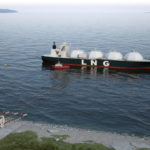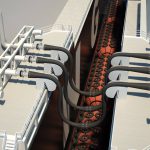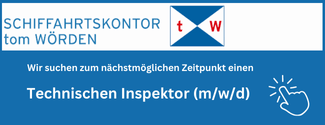An adequate transfer of fuel to the vessel’s tanks is in some areas still a task for the LNG industry. Trelleborg focuses on a new cryogenic hose as an alternative to traditional jetty-based transference
In terms of the chronology of energy source development, the Liquid Natural Gas (LNG) industry remains in its relative infancy[ds_preview], still at a stage of figuring out which infrastructural technology fits best given the very different nature of the product compared to oil and coal, for example. Innovative solutions to manage the supply and demand of LNG are therefore spawning as the market seeks to meet LNG’s growing demand. And while LNG will undoubtedly play a key role in the future energy mix, it has arrived amid a turbulent market where optimizing costs and keeping downtime to a minimum are essential for not only long term profitability but sometimes even for a company’s survival.
Safety has always been of paramount importance in the LNG industry, and finding a balance between operational efficiency and the highest possible safety standards is something the energy industry is constantly striving for. Traditional approaches to LNG are now becoming outdated as technology develops, with new innovations entering into the market enabling fresh thinking, particularly in the »transfer zone« where LNG is loaded and unloaded.
For the burgeoning offshore LNG market, floating receiving and distribution terminals and coastal gas carriers are now an integral part of the LNG supply chain as energy companies seek to streamline the supply chain. Traditional transfer has been conducted with twelve smaller 6 inch hoses. Cryoline technology from Trelleborg utilizes 12-inch to 16-inch hoses instead – enabling them to cope with a higher LNG flowrate of up to 10,000 m3/h and operate in any and all sea states – dramatically improving safety, and allowing faster transfer times, which in turn cut operating costs.
Trelleborg is the first company to receive EN1474-2 accreditation for its Cryoline LNG hoses, designed for fatigue resistance in even the most hazardous conditions – extending to up to 600m away from floating receiving and distribution terminals and coastal gas carriers to ensure optimized safety when required.
Looking beyond floating receiving and distribution terminals and coastal gas carriers towards terminal, liquefaction and regasification plants as well as gas power plants, conventional thinking has typically seen LNG requiring a permanent jetty transference, with breasting and mooring dolphins, fenders and loading arms. However, in some situations, such as in remote areas of the world, this can be difficult and cost-prohibitive.
Moreover, the importance of reliable and quick installation, and improved operability, cannot be downplayed as these are the factors which are going to contribute to economic viability, all key elements in any new regasification, liquefaction, terminal, or gas power plant construction projects. Cryoline floating hose-in-hose solutions offer new thinking: an alternative to traditional jetty based transfer when required.
As the LNG sector sees demand grow, safe, cost-effective and innovative technology surrounding loading and unloading transfers and ship-to-shore interface will be vital to keep up with the ever-challenging demands for LNG.
Author: Marco Urbino
Regional Manager MEA – Fluid Handling Operation, Trelleborg
marco.urbino@trelleborg.com
Marco Urbino


















